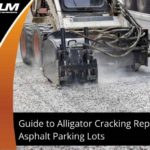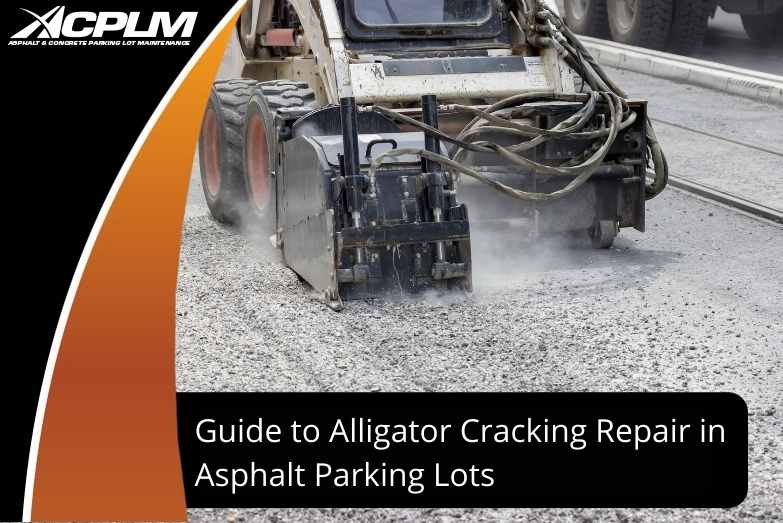
How to prepare your parking lot for Hurricane Season.
When it comes to maintaining a commercial property in Tampa Bay, one feature that is often overlooked, but absolutely vital, is proper stormwater drainage. This is especially true for parking lots, which are directly exposed to Florida’s intense storms, high humidity, and hurricane season downpours.
A well-designed and maintained parking lot drainage system protects your pavement, prevents costly damage, and enhances safety for customers, tenants, and employees. In this post, we’ll break down how proper stormwater drainage impacts the long-term performance of your parking lot and what commercial property owners can do to proactively manage drainage problems, cracks, potholes, and more.
Why Proper Stormwater Drainage Matters
In Tampa Bay, seasonal rains and tropical storms aren’t just inconvenient, they’re destructive if your parking lot isn’t designed to manage stormwater properly. Without a reliable drainage system, standing water can lead to:
- Asphalt deterioration
- Formation of potholes and cracks
- Flooded parking areas
- Increased liability for slip-and-fall injuries
- Costly, premature repairs
A poorly drained lot doesn’t just look bad, it can also compromise your property’s curb appeal, decrease pavement lifespan, and even turn into a liability nightmare.
Understanding Stormwater and Parking Lot Design
Water Management Starts with Grading and Slope
Stormwater must flow away from structures and walkways and toward the nearest drain or basin. This starts with proper grading during construction. Every commercial parking lot should be designed with a slope that directs water efficiently.
In many cases, the lot is slightly angled, usually 1–2%, to encourage water to flow toward inlets, trench drains, or standard catch basins. If the slope is too shallow or inconsistent, water tends to pool in low spots, creating standing water that weakens the asphalt over time.
The Role of Catch Basins and Trench Drains
Two critical components of any commercial parking lot drainage system are:
- Catch Basins: These act as collection points for stormwater runoff and debris. A standard catch basin connects to an underground pipe system that moves water away from the lot.
- Trench Drains: These long, narrow channels are ideal for collecting water over large areas and directing it to a drainage system. They are commonly placed along traffic lanes or entry/exit points.
Together, these tools reduce water buildup, protect your pavement from erosion, and keep your lot safe and navigable, even during heavy rainfall.
How Poor Drainage Leads to Parking Lot Damage
Water is the #1 enemy of asphalt. When stormwater is left to sit on the surface, it seeps into cracks, erodes the base layers, and causes potholes to form. Over time, you’ll notice:
- Widening cracks along traffic paths
- Alligator cracking (a telltale sign of structural failure)
- Waterline staining that indicates drainage issues
- Soft, sunken areas where water has penetrated the substrate
Each of these signs not only reduces the functionality and aesthetics of your lot, but also increases long-term parking lot maintenance and repair costs.
Sealcoating and Stormwater Defense
One of the most effective ways to protect your parking lot from stormwater damage is sealcoating. This process involves applying a protective coating over your asphalt that:
- Seals surface cracks
- Prevents water intrusion
- Shields against UV rays
- Extends the pavement’s lifespan
By adding a barrier between your asphalt and the elements, sealcoating helps minimize water-related potholes, cracks, and structural deterioration. Ideally, sealcoating should be performed every 3-5 years to maintain optimal protection.
Identifying and Fixing Drainage Problems
Even with a solid drainage design, drainage issues can arise over time due to:
- Clogged drains or basins
- Debris buildup from leaves, dirt, or trash
- Shifting or settling asphalt
- Hurricane season damage
The sooner you spot drainage problems, the better. Early intervention can save you thousands of dollars in parking lot repair.
Key Signs of Drainage Failure
- Persistent standing water after rain
- Water marks or algae growth
- Cracks or depressions near inlets
- Water flowing toward buildings or walkways
- Unusual erosion near curbs or medians
Tips for Improving Stormwater Drainage Design
1. Use Contour Mapping to Plan Drainage Flow
A contour map helps you identify natural slopes and flat areas in your parking area. With this data, you can determine where to place drains, curbs, and inlets for maximum efficiency.
If you discover low points, plan to install larger inlets or split drain systems to handle the additional water volume.
2. Install Sloped Asphalt or Berms
In flat areas, consider creating engineered slopes in the pavement itself. These subtle elevations help gravity pull water toward designated drains.
In addition, berms and curbs can guide water to desired locations while preventing it from pooling or flowing back toward structures.
3. Position Drains at High-Risk Zones
Drains should be strategically placed at:
- The lowest points of the lot
- Near pedestrian walkways
- Along traffic lanes
- At entry/exit points
- Between parking islands
You may also consider dual-channel drainage by splitting parking islands or curbs to collect water from multiple directions.
Potholes and Cracks: Prevention and Repair
How Water Creates Potholes
When stormwater enters even the smallest crack in your pavement, it begins eroding the base beneath. This repeated expansion and contraction, especially during Florida’s seasonal heat, weakens the structure and eventually collapses into a pothole.
Repairing Potholes in 3 Steps
- Clean the Area: Remove all debris, vegetation, and standing water.
- Fill and Compact: Use hot or cold asphalt mix and tamp down until level.
- Seal and Smooth: Properly compress and finish the repair to avoid future erosion.
The earlier you catch a crack, the cheaper and easier it is to fix.
Preparing for Hurricane Season in Florida
Every year, Tampa Bay faces the threat of heavy storms, high winds, and flash flooding during hurricane season. Without proper parking lot drainage, your property is at risk for:
- Flood damage
- Hazardous walking conditions
- Structural failures beneath the pavement
- Increased emergency repair costs
Now is the time to inspect your stormwater drainage system, clean out catch basins, and schedule any necessary parking lot maintenance before the next big storm hits.
Partner with Professionals for Long-Term Solutions
Proper stormwater drainage isn’t a one-time installation, it’s an ongoing process that includes:
- Design and engineering
- Grading and paving
- Sealcoating and crack repair
- Drainage system inspections
- Scheduled maintenance
At ACPLM, we specialize in commercial parking lot drainage, repair, and maintenance across Tampa Bay. Whether you’re installing a new drainage system, sealing existing pavement, or repairing potholes after a storm, our experienced team can handle it all.






